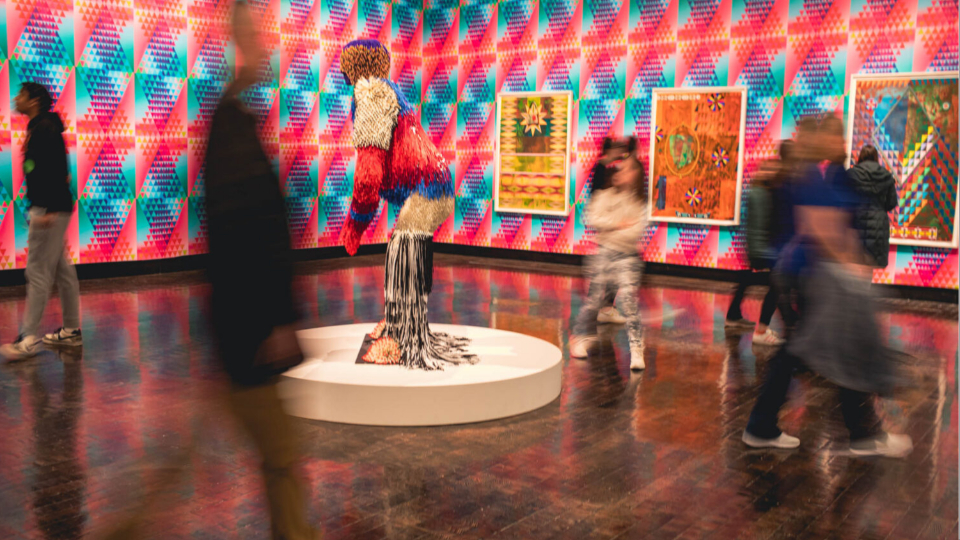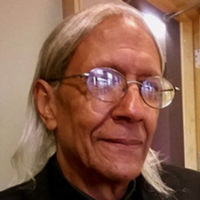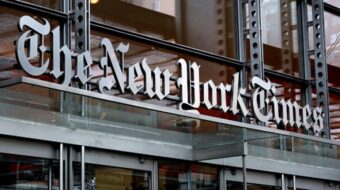
NASHVILLE— Artist Jeffrey Gibson, a celebrated member of the Mississippi Band of Choctaw Indians, is showcasing his work at the Nashville Frist Art Museum now through April 23. is Entitled “Jeffrey Gibson: The Body Electric,” the ground-breaking exhibition is a clarion call for Indigenous power, queer recognition, and environmental resistance to the carnage of profit-mad commercial and industrial development.
As a member of Indigenous and queer communities, Gibson says he feels the need to provide space in contemporary society for the constituencies to which he belongs. He’s also of Cherokee descent. And as a multidisciplinary artist—he’s a painter, sculptor, and installation artist—Gibson likewise addresses the very serious issue of the exclusion and erasure of Indigenous art from the history of Western art.
In a recent phone interview with People’s World, Gibson discussed his work and motivation.
“Curiously, the motivation is the freedom to do what I do. I like to look at where I end up. I work on many pieces at one time. I work as a painter with two dimensional paintings and drawings,” Gibson said.
Gibson has a BFA from the Art Institute of Chicago and an MA from the Royal College of Art in London. In 2019, he was the Recipient of a Macarthur Fellow “genius grant.” He is currently a visiting artist in residence at Bard College in New York. His work is in permanent collections throughout the United States.

His exhibition at Frist features a wide array of paintings, sculptures, videos, and installations, as well as a huge site-specific mural that visitors see first upon entering.
The title of the exhibition, “The Body Electric,” is taken from a song penned for the 1980 movie musical Fame, which was inspired by Walt Whitman’s famous 1885 poem “I Sing the Body Electric,” from Leaves of Grass. The song is meant to recognize the place of humanity in the natural world, hence, its relevance to this stellar exhibition.
The exposition is organized by Site Santa Fe and is part of the Tennessee Triennial for Contemporary Art, which is a program of Tri-Star Arts.
Gibson’s art draws heavily from his Indigenous heritage, combined with modernist explorations of color. It is further blended with influences from literature, music, fashion, history, politics, and Indigenous beadwork. Gibson said the latter ranks among his biggest influences. He also researches and collects beads of all types.
The artist’s penchant for writing is also encouraged by the fact that he is a collector of books that he also leverages for his work, particularly his paintings. In reference to writing in his art, he cites Indigenous poets going back to the 19th century and Biblical scriptures.
He also mentioned that both his grandmothers made quilts and that there was also weaving and basket-making in his family. Artistically, he further cites the influence of other artists, including famed Dakota artist Oscar Howe and celebrated African American muralist Aaron Douglas.
His art takes the viewer through a dazzling panoply of paintings, sculptures, films, and installations. Gibson is not only an accomplished artist but also a profound, insightful philosopher whose thoughts abundantly filter into his renderings.
Gibson’s art has been described as “Indigenous Futurism.” He muses as to what Native life will look like in the future and contemplates that our past is our future, for the present and the future is based upon and is a part of the past.
As a youngster, Gibson said he was always drawing. His family moved around a lot, as his father was a civil engineer whose government job took him around the world. Young Gibson sent drawings to his relatives in Mississippi and Oklahoma while growing up in Germany and South Korea. He found his time out of the United States formative.
Although heavily influenced by his Native heritage, he also has interests in other aspects of the cultural milieu of the U.S., many of which show up in his work.
“My relationship with U.S. subcultures, such as the Chicago House Music, and my immersion in the New York artist community was also formative,” remarked Gibson.
Among the highlights of “The Body Electric” at the Frist, the very first work to be seen is the on-site mural “The Land is Speaking/ Are You Listening,” which evokes the Indigenous viewpoint of Mother Earth and the connection that we should all have with the land.
Equally compelling is “Tribes File Suit to Protect Bears Ears,” a combination of banner, clothing, and sculpture. The historical background to this work was that it was composed at a time of increased advocacy for environmental and social justice for oppressed peoples, including Indigenous nations, Murdered and Missing Indigenous Women, Black Lives Matter, and other marginalized communities and movements.
It takes its name from the Bears Ears National Monument in southeastern Utah, the ancestral land of a number of Indigenous nations in the region.
Also, awe-inspiring is “Large Figures,” which portrays a spectrum of genders in contradistinction to mainstream binary concepts. These were inspired by Gibson’s contacts with dolls from Indigenous nations of the Great Plains. They are towering beaded figures covered with thousands of stacked bone pipes.
Any one of these figures would take hundreds of hours to compose. Upon viewing them, it is quite easy to imagine they were actually mobile and alive.
Another installation of great import is “Red Moon, Desert Sky, and Red Sunset.” It consists of three giant brightly-colored columns of nylon shawl fringe which is usually found on the regalia of dancers. These sculptures are approximately 10 feet tall and evoke the impression of hanging columns on the one hand and of a humanity on the other exuding from the material.
Equally impressive are Gibson’s punching bags—intricately embroidered punching bags—a form he is so well known for originating. They are meant to represent power and the oppressed—the power of the oppressor and the marginalization of the oppressed. This art form is extremely thought-provoking.
The punching bags represent the recipients of repeated violence, but by covering them with beadwork, the bags are “Indigenized.” They are thus given the power and ability to withstand the blows of colonialism.
Again, there is a lot of writing in his work. Interspersed throughout the exhibit is text, much of it by the artist himself. But there are also phrases from artists running the gamut from Stevie Wonder to the Culture Club.

In the process of narrating the exhibit, the text addresses ongoing political, environmental, and social issues. “The Land is Speaking / Are You Listening,” for instance, brings attention to the unrelenting industrial capitalist onslaught on the earth, the profit-obsessed juggernaut wielding massive destruction of the natural environment.
Phrases such as “I Am a Rainbow Too,” “The Future is Present,” and “War Is Not The Answer, Feel Something Real” are emblematic of the philosophical leanings of Gibson.
His art is one of messages; it is political but also emblazoned with love and the ability to remain hopeful. He stays inspired by “the strength that Native people have shown” and the fact “that they did not give up.”
The exhibition at the Frist is on until April 23 and richly deserves careful reflective viewing and multiple visits.
We hope you appreciated this article. Before you go, please support great working-class and pro-people journalism by donating to People’s World.
We are not neutral. Our mission is to be a voice for truth, democracy, the environment, and socialism. We believe in people before profits. So, we take sides. Yours!
We are part of the pro-democracy media contesting the vast right-wing media propaganda ecosystem brainwashing tens of millions and putting democracy at risk.
Our journalism is free of corporate influence and paywalls because we are totally reader supported. At People’s World, we believe news and information should be free and accessible to all.
But we need your help. It takes money—a lot of it—to produce and cover unique stories you see in our pages. Only you, our readers and supporters, make this possible. If you enjoy reading People’s World and the stories we bring you, support our work by donating or becoming a monthly sustainer today.












Comments